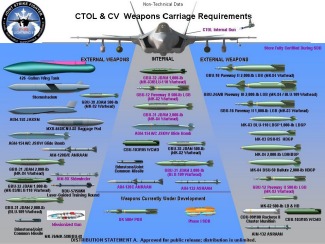
From a Solari Report Subscriber
The F-35 Joint Strike Fighter (JSF) program is the most expensive weapons program in US Defense Department history, costing almost 1.5 trillion dollars for around 2500 aircraft.
The details I am examining here are entirely based on articles I have read in the media and not on experience. My interest on this issue stems entirely from my curiosity about one of the biggest engineering contracts of all time.
I will try to summarize the information in short sections, as concisely as possible:
1. Outline of the F-35 program
1.a. Clients and Technology
The main idea behind the F-35 program is the fact that the US services (Air Force, Navy and Marines) can have a common platform for aircraft which can be expanded to three variants:
1. F-35A (Conventional take-off and landing variant, for the Air Force)
2. F-35B (Short take-off and landing variant, for the Marines)
3. F-35C (Carrier based variant, for the Navy).
The fundamental logic behind the common platform idea is obviously cutting costs down, and less obviously to reach a compromise between services, on which I will detail later.
(There is a long introductory and flattering text on this idea of common platform in the following book (pages 110-114):
1.b. Cost
“The government now projects that the total cost to develop, buy and operate the Lockheed Martin Corp F-35 Joint Strike Fighter will be $1.51 trillion over the next 50-plus years”. (Chicago Tribune, 2012).
http://articles.chicagotribune.com/2012-04-02/news/sns-rt-us-lockheed-fighterbre8310wb-20120402_1_problems-or-cost-increases-technical-problems-or-cost-f-35
1.c. Contractors
The main contractor of the project is Lockheed Martin.
http://www.lockheedmartin.com/us/products/f35.html
Other big companies involved are Northrop Grumman, British Aerospace and Alenia.
2. What are the problems with the F-35 program?
2.a. Spiraling costs: 64% over a decade.
http://www.bloomberg.com/news/print/2011-11-03/lockheed-s-f-35-costs-rose-64-over-decade-in-rich-man-s-world-.html
“Affordability for the U.S. and partners is challenged by a near doubling in average unit prices since program start and higher estimated life-cycle costs.” (GAO report, 2011)
http://www.gao.gov/products/GAO-11-677T
2.b. Behind schedule:
“After more than 9 years in development and 4 in production, the JSF program has not fully demonstrated that the aircraft design is stable, manufacturing processes are mature, and the system is reliable.” (GAO report, 2011)
http://www.gao.gov/products/GAO-11-677T
2.c. Persistent technological problems:
There are several technical issues with major consequences:
http://www.pogo.org/resources/national-security/f-35-jsf-concurrency-quick-look-review-20111129.html
3. What are the reasons behind the problems in the F-35 program?
3.a. Too much design compromise trying to make everyone happy:
The fundamental idea of “common platform” behind the project has become the main source problem. Too many incompatible technological requirements made the design faulty from the beginning. For example:
1. Marine versus Air Force: Short airframe with single engine requirement for the Marines, long airframe with excessive power for the Air Force.
2. Fighter versus Bomber: The aircraft must be agile for dog fighting but also stealthy for bomber missions, which increase the weight considerably.
http://www.foreignpolicy.com/articles/2012/04/26/the_jet_that_ate_the_pentagon?page=0,1
Other similar too much compromise fiascos exist in US military acquisition program history. For example:
B-1B Bomber: Had to be high-altitude supersonic flight and terrain-following bomber at treetop level all at the same time.
3.b. Rivalries between too many stakeholders:
This is a very interesting point of view very beautifully described in this book: (http://www.amazon.com/Trillions-Military-Technology-Pentagon-Innovates/dp/1403984263)
Here is a summary paragraph:
“Defense firms have only one customer, the federal government (foreign sales are subject to Washington’s approval). But government is not a unitary customer. The services compete for acquisition dollars and they also compete internally—for submarines as opposed to aircraft carriers, for tanks as opposed to helicopters, for fighters as opposed to bombers. These rivalries often have greater effects on technological choice (and force structure) than rivalries among the services (e.g., between Air Force and Navy for aerospace missions that either in principle could perform). The Office of the Secretary of Defense (OSD) maintains shaky civilian control over all this, Congress often becomes involved, the White House is a party to big decisions and sometimes becomes involved when quite prosaic undertakings go off the tracks: President John F. Kennedy intervened personally in the M16 rifle program. In the field, militaries insist on clear-cut, unambiguous chains of command because lives depend on it. No such imperatives exist in acquisition.”
3.c. Production began before testing flights ended (“Concurrency”)
Concurrency means overlapping of testing and production yet also buying a product before it is fully developed. In the case of F-35, there were too many issues discovered by the testing, which slowed the production considerably.
But there is also the risk of low-rate production leading to higher unit prices:
http://www.washingtontimes.com/news/2012/may/11/real-consequences-of-delaying-f-35-program/
4. Cost-plus contract acquisition practices:
I am sure you are aware that most of the defense and space contracts in US are based on cost-plus contract basis, which means a contractor is allowed some profits over its incurred costs. With the natural result that the costs are always bigger than expected :o)
Some videos on F-35 you may enjoy:
http://www.youtube.com/watch?v=cORX4hdHEsg&feature=related

